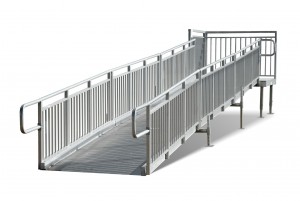You might be wondering, “Where are ADA ramps required?” The answer is simple – every building that provides access to the general public needs to have ramps that are accessible by people using wheelchairs and other mobility aids, such as walkers and canes. Failure to be ADA compliant can lead to severe financial penalties, and leave you open to potentially expensive lawsuits. REDD Team experts can make sure you don’t have to deal with those problems.
Specific Requirements
 The Americans With Disabilities Act goes into great detail when it comes to ramps used in either existing facilities or new structures. Here’s a quick look at just a few of the requirements.
The Americans With Disabilities Act goes into great detail when it comes to ramps used in either existing facilities or new structures. Here’s a quick look at just a few of the requirements.
- Landings – The areas at the top and bottom of the ramp, known as the landings, need to be at least the same width as the ramp itself. It must not be any shorter than 60 inches, or five feet. If the ramp changes direction, the landings have to be no smaller than 60 inches by 60 inches. If a landing is to be placed in an area that tends to get wet, it must be made out of materials that don’t accumulate water. Our aluminum ramps fulfill all of these requirements and more. Unlike steel and other materials, aluminum drains water very efficiently – no matter how hard it rains.
- Rise, slope and width requirements – ADA ramps must have a slope that doesn’t exceed 1:12. That means for every 12 units of measurement the ramp runs, the slope can’t be more than one unit. There are some exceptions, however. If your existing facility has a limited amount of space, you may be allowed to install a steeper slope. We can work closely with you to make sure your ramps meet all slope requirements.
- Handrails – If your ramp is to rise more than six inches from the ground, it must attach to handrails. They must run the same length as the ramp, and there also must be a space of 1.5 inches between the handrails and ramp. Handrails must also be affixed solidly to the ramp, and not move when used. REDD Team handrails are smooth and continuous, providing a safe, secure grip.
These just scratch the surface of the many, many ADA requirements that govern the installation of ramps. Your ramps will not only need to conform to the ADA, but also state and local requirements as well. In some cases, these requirements will be even more stringent.
If you don’t have the time to research all the specifics of the ADA and other accessibility system requirements, REDD Team can take that responsibility off of your plate. We have more than 25 years of experience constructing ramps, stairs and other accessibility components, and we know the ADA in and out. We will also know the specific requirements of the area in which your building is located.
Contact REDD Team to Learn More
Even though the answer to the question of, “Where are ADA ramps required?” may be easy, conforming to the ADA is anything but. At REDD Team, however, we will be more than happy to answer any questions you may have. Just give us a call at (800) 648-3696 or use our online form to get in touch. We’ll make sure you don’t need to deal with any of the issues that can develop due to non-compliance.
